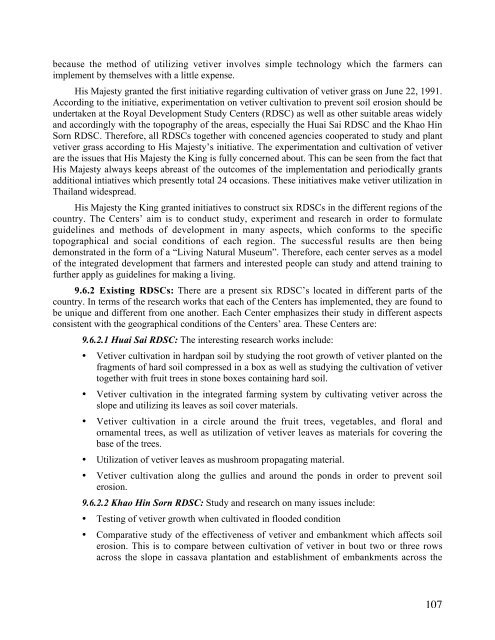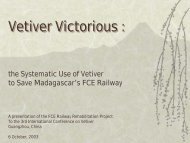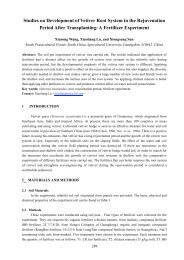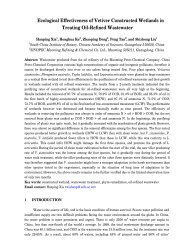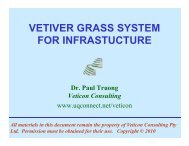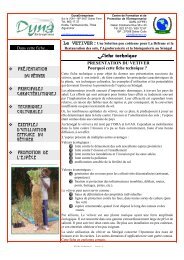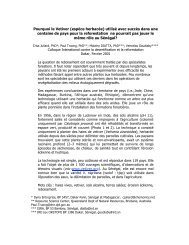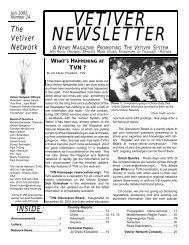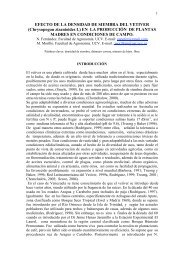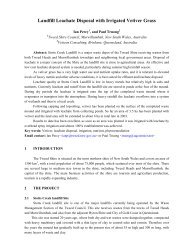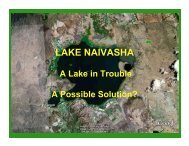Training manual - The Vetiver Network International
Training manual - The Vetiver Network International
Training manual - The Vetiver Network International
You also want an ePaper? Increase the reach of your titles
YUMPU automatically turns print PDFs into web optimized ePapers that Google loves.
ecause the method of utilizing vetiver involves simple technology which the farmers can<br />
implement by themselves with a little expense.<br />
His Majesty granted the first initiative regarding cultivation of vetiver grass on June 22, 1991.<br />
According to the initiative, experimentation on vetiver cultivation to prevent soil erosion should be<br />
undertaken at the Royal Development Study Centers (RDSC) as well as other suitable areas widely<br />
and accordingly with the topography of the areas, especially the Huai Sai RDSC and the Khao Hin<br />
Sorn RDSC. <strong>The</strong>refore, all RDSCs together with concened agencies cooperated to study and plant<br />
vetiver grass according to His Majesty’s initiative. <strong>The</strong> experimentation and cultivation of vetiver<br />
are the issues that His Majesty the King is fully concerned about. This can be seen from the fact that<br />
His Majesty always keeps abreast of the outcomes of the implementation and periodically grants<br />
additional intiatives which presently total 24 occasions. <strong>The</strong>se initiatives make vetiver utilization in<br />
Thailand widespread.<br />
His Majesty the King granted initiatives to construct six RDSCs in the different regions of the<br />
country. <strong>The</strong> Centers’ aim is to conduct study, experiment and research in order to formulate<br />
guidelines and methods of development in many aspects, which conforms to the specific<br />
topographical and social conditions of each region. <strong>The</strong> successful results are then being<br />
demonstrated in the form of a “Living Natural Museum”. <strong>The</strong>refore, each center serves as a model<br />
of the integrated development that farmers and interested people can study and attend training to<br />
further apply as guidelines for making a living.<br />
9.6.2 Existing RDSCs: <strong>The</strong>re are a present six RDSC’s located in different parts of the<br />
country. In terms of the research works that each of the Centers has implemented, they are found to<br />
be unique and different from one another. Each Center emphasizes their study in different aspects<br />
consistent with the geographical conditions of the Centers’ area. <strong>The</strong>se Centers are:<br />
9.6.2.1 Huai Sai RDSC: <strong>The</strong> interesting research works include:<br />
<strong>Vetiver</strong> cultivation in hardpan soil by studying the root growth of vetiver planted on the<br />
fragments of hard soil compressed in a box as well as studying the cultivation of vetiver<br />
together with fruit trees in stone boxes containing hard soil.<br />
<strong>Vetiver</strong> cultivation in the integrated farming system by cultivating vetiver across the<br />
slope and utilizing its leaves as soil cover materials.<br />
<strong>Vetiver</strong> cultivation in a circle around the fruit trees, vegetables, and floral and<br />
ornamental trees, as well as utilization of vetiver leaves as materials for covering the<br />
base of the trees.<br />
Utilization of vetiver leaves as mushroom propagating material.<br />
<strong>Vetiver</strong> cultivation along the gullies and around the ponds in order to prevent soil<br />
erosion.<br />
9.6.2.2 Khao Hin Sorn RDSC: Study and research on many issues include:<br />
Testing of vetiver growth when cultivated in flooded condition<br />
Comparative study of the effectiveness of vetiver and embankment which affects soil<br />
erosion. This is to compare between cultivation of vetiver in bout two or three rows<br />
across the slope in cassava plantation and establishment of embankments across the<br />
107


